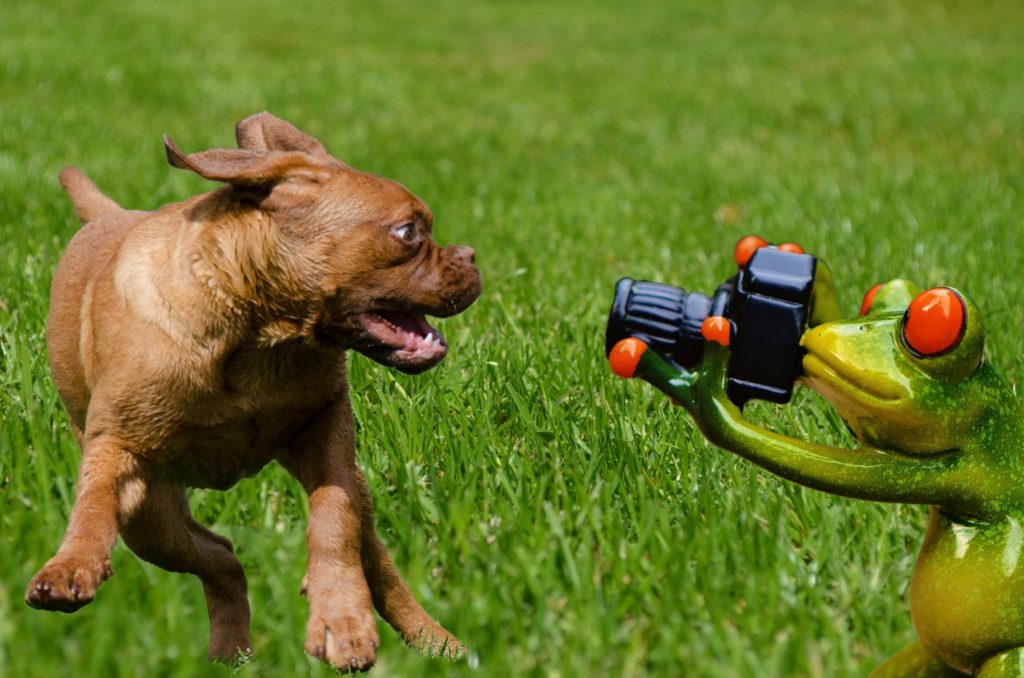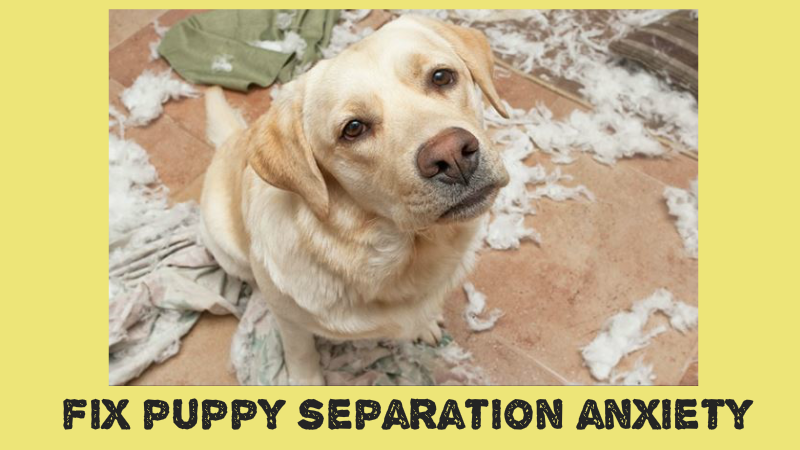Puppy Separation Anxiety
How to Prevent Separation Anxiety In Puppies
Separation anxiety, also known in the dog training world as owner absent misbehavior, is one of the most frequently encountered problems in the world of dog training. Separation anxiety can manifest itself in many different ways, including chewing, destroying the owner’s property, excessive barking, self-destructive behavior, inappropriate urination and defecation. Most dogs want to be close to their humans at all times and those that haven’t been taught how to stay alone may exhibit unwanted behaviors. The best approach is to gradually adjust your pet to being alone.
Common Separation Anxiety Behaviors
Dogs suffering from separation anxiety often whine, bark, cry, howl, dig, chew and scratch at the door the entire time their family members are away. Well meaning owners often unwittingly encourage this misbehavior by rushing home to reassure the dog, but it is important for the well being of both dog and owner that the dog learns to deal with extended periods of separation.
Avoid Long Drawn Out Farewells
How the owner leaves the house can often contribute to separation anxiety issues. A long and drawn out period of farewell can make matters worse by making the dog feel even more isolated when the owner finally leaves. These long types of farewells can get the dog excited, and then leave him with lots of excess energy and no way to work it off. These excited, isolated dogs often work off their excess energy in the most destructive of ways, such as chewing up a favorite rug or piece of furniture.
Signs of Serious Separation Anxiety
Most dogs, especially puppies, may whine or cry a little when left alone. True separation anxiety is defined as destructive or disruptive behavior, including tearing up the room, constant barking and whining or housetraining mistakes every time you leave. This often starts immediately after you leave. In such cases, you may want to consult a qualified dog trainer or behavior professional.
Excess Energy or Separation Anxiety
Excess energy is often mistaken for separation anxiety since results are often the same. If you think that excess amounts of energy may be the problem, try giving your dog more exercise to see if that eliminates the problem.
Preventing Separation Anxiety
If separate ion anxiety is truly the problem, it is important to address the root causes of that anxiety. In order to prevent separation anxiety from occurring, it is important for the dog to feel happy, safe, secure and comfortable while the owner is away for the day. It is important, for instance, to give the dog plenty of things to keep it busy while you are away. This means providing it with lots of toys, such as balls or chew toys. A pet companion is often effective at relieving separation anxiety as well. Giving the dog a playmate, such as another dog or a cat, is a great way for busy pet parents and pets alike to cope with the stress of being left alone.
8 Simple Steps to Make Your Puppy Comfortable
• Start by introducing your dog to his crate. Crate him for short periods while you are present and gradually increase the time crated.
• Reward quiet behavior with calm praise and perhaps a treat such as a piece of dog food.
• Start leaving your puppy alone. At first, just a few minutes at a time and then gradually increase it.
• Limit your attention when you are home so it isn’t such a shock when you leave.
• Reward your dog with a piece of food and attention when he lies quietly away from you.
• Plenty of exercise helps dogs who must be alone for long periods.
• If you work, consider hiring a walker to give your dog a midday break.
• Keep your schedule similar on weekends and workdays can help make things easier for your dog.
Remember that most puppies will not be ready to be given unsupervised freedom in your home until they are a year-and-a-half or older.
Playtime to Take the Edge off Separation Anxiety

Setting aside scheduled play times, during which the pet is given your undivided attention, is another great way to alleviate boredom and separation anxiety. Playing with the dog, and providing it with sufficient attention and exercise, is a proven way to avoid a stressed and anxious dog. A happy dog that has been well exercised and well conditioned will generally sleep the day away happily and patiently wait for the return of its owner.
It is important to schedule one of these daily play sessions before you leave the house each day. It is important to give the dog a few minutes to settle down after playtime before you leave.
Already Seeing Anxiety Behavior in Your Canine?
For dogs that are already experiencing separation anxiety and associated misbehaviors, it is important to get him accustomed to your leaving gradually. Be sure to practice leaving and returning at irregular intervals, several times during the day. Doing so will get your dog accustomed to your departures and help him realize that you are not leaving him forever. Dogs that have been previously lost, or those that have been surrendered to shelters and readopted, often have the worst problems with separation anxiety. Part of treating this problem is teaching the dog that your leaving is not permanent.
Leaving and Arriving
Do your best to make leaving and arriving uneventful. If you make leaving a big production – lots of hugs and goodbyes or asking if he’ll miss you – your dog will assume it’s a big deal.
Those of you that have pre-school age children may well be familiar with an occasional “Mommy, Don’t leave me drama” when being dropped off at the preschool. A couple of years back we experienced this first hand with one of our daughters. We found that the longer we “hovered” around hoping she would get over her anxiety at us about to leave, the more desperate the behavior became. We soon realized that the best way for us all to get on with the day was to drop her off and minimize the time spent with the hugs and kisses goodbye (Think quality over quantity…) She soon realized that we would be there at the end of then preschool session to pick her up. So, I guess we all learned as those first weeks flew by.
These same principals will apply to that new little puppy. As soon as they realize that the absence is not forever, the behavior will settle. When you return, don’t go directly to his crate and make a fuss except if your dog is a young pup or has been left for many hours. In these cases, take him outside straight away as he may really need to relieve himself and making him wait can lead to a wet crate. If you can wait until your dog is calm and quiet, then casually go greet him and praise him for being calm and quiet.
Tricks to Minimize Separation Anxiety

Your puppy is a very observant creature. They will soon pick up on the cues that indicate your imminent departure. Things such as the jingling of keys as you prepare to head out of your home, or putting on shoes or a jacket before heading out. What can I do to offset these potential anxiety precursors?
Easy…Just fake a few times with the keys and your shoes and jacket. Depart from the house for a very short period at first (less than one minute), and then come back. You can gradually increase the time outside, monitoring your puppy’s behavior while doing so. Don’t forget to reward your puppy with a treat and praise if the behavior is good.
How Long Can This Anxious Behavior Last?
The actual time will vary according to breed and household circumstances, but within a few weeks, with the correct steps being followed through with, you should no longer see the distress in your puppy when you leave the home.
Signs of Serious Separation Anxiety
Most dogs, especially puppies, may whine or cry a little when left alone. True separation anxiety is defined as destructive or disruptive behavior, including tearing up the room, constant barking and whining or housetraining mistakes every time you leave. This often starts immediately after you leave. In the worst case scenarios, if the behavior does not settle at all during your absence, it may start to cause some grief with nearby neighbors.
If you need to leave your puppy home alone it is not possible to make occasional trips home during your work day, you may consider asking a friend to swing by and spend a little time with your puppy. It usually helps as well to ask your neighbors to let you know if there is any noise from your home that may indicate a puppy showing anxious behavior.
Local laws and regulations are quite firm with respect to complaints arising from noise due to distressed pets. In such cases, you may want to consult a qualified dog trainer or behavior professional.
Outside Help Is Available
These days, there is a lot of help available for people in the same situation as you. Check out Rover.com They have a presence in many of the cities in the USA and may be able to assist with some company for your puppy when you are not able to be there.

